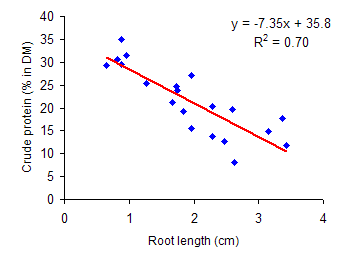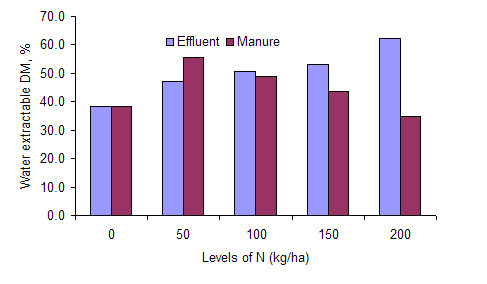Manure or biodigester effluent as fertilizer for duckweed
Keansombath Lampheuy
National University of Laos (NUOL)
Vienetiane, Laos
lampheuylam@hotmail.com
Abstract
An experiment to compare the growth response of duckweed (Lemna minor) to increasing concentrations of N from two sources of substrates was conducted. The substrates were raw cow manure (M) and effluent from biodigesters charged with cow manure (E). The experiment took place in An Giang University, Long Xuyen district, An Giang province, Vietnam. Raw cow manure and biodigester effluent were used as the fertilizers with five levels of N (0, 50, 100, 150 and 200 kg/ha), according to a 2 x 5 factorial arrangement with 2 replications per treatment with the split-plot design. Average air and water temperature during the test were 26 to 31 oC and 25 to 27 oC with the highest in the midday, when temperature was 38 and 29 oC, respectively. Plastics baskets lined with plastic film were used as experimental ponds. The surface of water in each basket was 0.16 m2 with 10 cm depth, and the volume was 16 liters. Duckweed (Lemna spp) was inoculated at a rate of 200 g/m2 (30 g/basket). The yield of duckweed was calculated by subtracting the inoculum from the total biomass production measured every 48 hours and was expressed as fresh duckweed yield g/m2/day. The fertilizers were applied five times in equal amounts during the experiment (20 days), according to the levels in each treatment.
There was no significant (P=0.85) interaction level*fertilizer for biomass production and type of fertilizer. Duckweed yield increased linearly with level of N in the fertilizer and was higher for effluent than for manure. Root length was shorter when the ponds were fertilized with the effluent, root length being negatively correlated with protein content of the duckweed (R2 = 0.82 for E and R2 = 0.71 for M) and with biomass yield (R2 = 0.54 for E and M combined). Crude protein content in duckweed increased with N level applied and was higher for effluent than for manure.
It is suggested that biodigester effluent is a better N fertilizer
than the raw manure for duckweed production in small ponds. Root length can be used as
a simple and cheap
indicator of biomass yield and crude protein content in duckweed.
Further studies concerning the sources of N for increasing the N content of
duckweed production are suggested to improve the efficiency of
integrated farming systems in developing countries.
Key words: Duckweed, Lemna minor, raw cow manure, biodigester
effluent
Introduction
Duckweed (Lemna spp.) is a water plant that is rich in nutrients. It has been used as a main protein supplement for pigs (Bui Hong Van et al 1997) and ducks (Bui Xuan Men et al 1995; Nguyen Duc Anh et al 1997b) and also as a source of minerals for ruminants (Leng et al 1995). Duckweed has received research attention because of its high nutritive value, especially the high protein content and also because of its capacity to grow rapidly on nutrient-rich waste water and produce biomass rich in protein (Leng et al 1995).
Recently, several studies on duckweed have been conducted on growth and as a supplement feed to animals. In this connection, it has been reported that duckweed has a stimulating effect on live weight gain explained by an additional protein intake (Du Thanh Hang 1998). Also, a diet with 100 % replacement of soya bean by duckweed was the most profitable for farmers (Bui Xuan Men et al 1995). On the other hand, several experiments have also been conducted on growth of duckweeds under different conditions. The results from these studies showed that the growth of duckweeds is similar to that of any other plant. Moderate conditions of temperature and light and liquid medium with the necessary nutrients are essential for good growth. Also, duckweeds adapt well to a wide range of conditions and are easy to grow (Cross 2001).
It is considered that the use of effluent from biodigester for growing duckweeds could be a way of increasing feed availability for animals and at the same time reducing problems of pollution to the environment.
Objective
The aim of this experiment was to study the growth
and N content of duckweed as influenced by increasing
concentrations of raw cow manure and effluent from biodigesters charged
with the same raw cow manure.
Material and methods
Location and temperature
The experiment was conducted in the experimental area of the An Giang University, An Giang province, Vietnam, and lasted for 20 days.
Treatments
Two fertilizers were compared:
- Raw cow manure (M)
- Biodigester effluent (E)
Each fertilizer was used in five treatments equivalent to levels
of N of 0, 50, 100, 150 and 200 kg/ha. The raw cow manure was from cattle fed maize and rice straw
in a dairy farm near Long Xuyen City,
An Giang province, Vietnam. The effluent was from a biodigester
installed at the An Giang University, which was charged with the same cow manure.
Experiment design
The experiment was designed as a split-plot factorial arrangement (2 x 5) with two replications (blocks). Each replication consisted of 10 plastic baskets (5 levels; two types of manure), the treatments being allocated at random within each block (Table 1).
Table 1: Arrangement of treatments |
|||||
|
|
Level of N, kg/ha |
||||
|
200 |
0 |
100 |
150 |
200 |
|
|
Replicate 1 |
M |
E |
M |
M |
M |
|
E |
M |
E |
E |
E |
|
|
|
0 |
100 |
150 |
50 |
200 |
|
Replicate 2 |
M |
M |
E |
M |
M |
|
E |
E |
M |
E |
E |
|
Management and data collection
Plastic baskets lined with plastic film were used as experimental ponds. The surface of water in each basket was 0.16 m2 with 10 cm depth giving a volume of 16 liters. Duckweed was inoculated at a rate of 200 g/m2 in each treatment. The first day, the different fertilizers with different levels were added to each treatment.
Manure was analyzed for N content every five days before being applied. However, the biodigester effluent was stored in a container (50 liters) and a sample analyzed at the beginning of the experiment. Fertilizer was applied every four days according to the level of N in each treatment (Appendix 1 shows the total amount of fertilizers that were used in each level).
Yield of duckweed and root length of the duckweed were determined at each harvest every two days. The root length was measured with a graduated ruler (Rodriguez and Preston 1996). At each harvest, all the biomass was removed from each basket and weighed. Thereafter, 30 g of duckweed were returned to the basket as inoculum. In every harvest, samples of duckweed were taken and bulked for analysis. DM content in duckweed was determined by drying the sample in a microwave radiation (Undersander et al 1993). The first and the last harvest of duckweed were analyzed for N content, and also for every three successive harvests of duckweed samples were taken and mixed for determination of N content following standard procedures (AOAC 1995). Water extractable DM and N in duckweed were analyzed in the last harvest according to Ly and Preston (1997). In addition, at the beginning and every five days, water from each basket was sampled for analyzing pH with a glass electrode in a digital pH meter, and NH3-N by steam distillation of samples treated with 40% NaOH..
Data analysis
Data were subjected to analysis of variance following the GLM option of the ANOVA software of Minitab version 13. Sources of variation in the model were sources of fertilizer, levels of fertilizer, interaction source*level and error.
Results and discussion
Biomass yield increased with level of fertilizer and was higher for the effluent than for the manure (Table 2; Figure 1). This agrees with the findings of Le Ha Chau (1998) who also compared biodigester effluent with manure but at a fixed N level of 150 kg/ha. There was no interaction level*fertilizer for biomass production.
Table 2. Some characteristics of duckweed grown on different sources and levels of N |
||||||
Level of N (kg/ha) |
Yield (g/m2 per day) |
Root length (cm) |
Nitrogen (% DM) |
|||
|
Effluent |
Manure |
Effluent |
Manure |
Effluent |
Manure |
|
|
0 |
12.2 |
7.8 |
2.09 |
2.21 |
2.66 |
2.71 |
|
50 |
44.4 |
28.6 |
2.05 |
2.68 |
3.95 |
3.35 |
|
100 |
60.2 |
44.7 |
1.27 |
2.31 |
4.87 |
3.46 |
|
150 |
65.6 |
54.4 |
0.91 |
1.96 |
5.32 |
3.49 |
|
200 |
63.6 |
62.2 |
0.94 |
1.58 |
5.53 |
4.26 |
Mean |
49.2 |
39.5 |
1.45 |
2.15 |
4.46 |
3.45 |
SEM |
0.56 |
0.63 |
0.24 |
|||
Root length decreased with increasing N application and was shorter in the
treatments with effluent compared with manure. The interaction level*fertilizer was
significant for root length the difference between the effluent and the manure
increasing as the level of N was increased (P= 0.008). Root length were
negatively correlated with protein content of the duckweed (Figure 3;
R2 = 0.82; Figure 4 ;R2 = 0.71, for effluent and
manure respectively) and with
biomass yield (Figure 5 ;R2 = 0.54). These findings are similar to
those reported by Le
Ha Chau (1998).
The percentage of N in duckweed was increased (P=0.005) by fertilizer N level and was higher for effluent than for manure. There was no interaction (P=0.45) for N level*fertilizer.
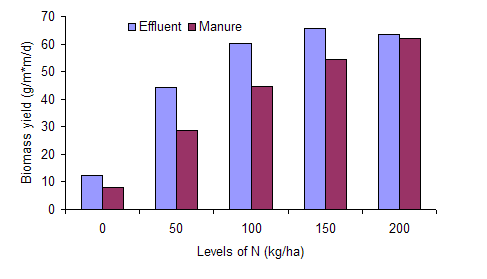
Figure 1. Biomass yield of duckweed cultivated with increasing levels of effluent and raw cow manure
There was a close relationship (R2 = 0.81 for effluent and
R2 = 0.71 for manure) between root length and crude protein content
of duckweed (Figures 2 and 3). It has been claimed
that duckweed root length can be used as a
indicator of protein content in this water plant (Rodriguez and Preston 1996; Nguyen Duc Anh
and Preston 1997a,b, 98; Le Ha Chau
1998; Phengsavanh Phonepaseuth 2001). The results of the present
study confirm the usefulness of this relationship.
|
|
|
Figure 2:
Relationship between root length and crude protein
content of duckweed grown in water fertilized by biodigester
effluent
|
Figure 3:
Relationship between root length and crude protein content of duckweed grown in
water fertilized by raw cow manure
|
There was a good relationship ( R2 = 0.54) between root length and
biomass yield, as when the roots were
long, the duckweed biomass yield was low. Therefore the relationship
between root length and biomass yield can be used as indicator for
the yield and crude protein content of duckweed, in agreement with
findings of Le Ha Chau (1998).
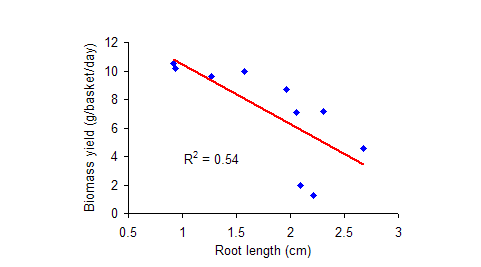
Figure 4. Relationship between root length and biomass yield of duckweed
The interaction N level*fertilizer was significant (P= 0.001)(Figure 5) for water extractable DM which increased linearly (R² = 0.95) with increasing N from effluent but showed a curvilinear relationship (R² =0.80) with N level on the manure. The results with the effluent are similar to those reported by Phengsavanh Phonepaseuth (2001); however, this parameter does not appear to have been studied with manure as fertilizer.
Figure 5. Effect of fertilizer N level in effluent and manure on water extractable DM of duckweed
Thee was no effect of fertilizer N level, or source, on the DM content of the duckweed nor on the water-extractable N (Table 3). Crude protein increased with fertilizer N level but the rate of increase was more marked with the effluent (Figure 6). The increase in crude protein content with N level in the effluent is in agreement with the findings of Phengsavanh Phonepaseuth (2001).
|
Table 3. Chemical characteristics of duckweed grown in water fertilized with different sources and levels of N |
||||||
|
Level of N (kg/ha) |
Dry matter |
Crude protein |
Water extractable N |
|||
|
Effluent |
Manure |
Effluent |
Manure |
Effluent |
Manure |
|
|
0 |
4.99 |
5.62 |
16.7 |
16.9 |
69.6 |
72.9 |
|
50 |
5.85 |
4.90 |
24.7 |
21.0 |
61.9 |
81.8 |
|
100 |
5.40 |
6.00 |
30.5 |
21.6 |
68.9 |
65.8 |
|
150 |
5.83 |
5.98 |
33.2 |
21.8 |
64.1 |
54.9 |
|
200 |
5.21 |
6.34 |
34.5 |
26.6 |
75.4 |
62.7 |
|
Mean |
5.45 |
5.77 |
27.9 |
21.6 |
68.0 |
67.6 |
|
SEM |
0.45 |
1.48 |
1.14 |
|||
The results obtained from the present study with high level of effluent were similar to the
data of duckweed grown under ideal conditions and harvested
regularly (DM of around 5%; and crude protein of 34%) as reported by
Leng et al (1995).
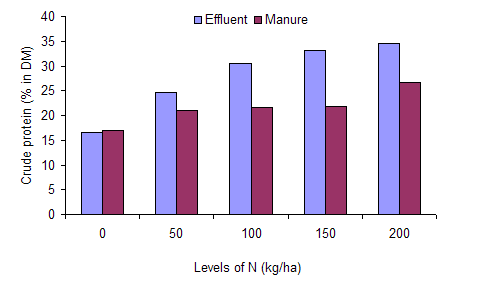
Figure 6.
Crude protein content of duckweed grown in water
fertilized with
different sources and levels of N
The ammonia nitrogen content in the pond water increased with fertilizer level but was not different between effluent and manure (Table 4). fertilized by different sources and levels of nitrogen and pH value. Water pond contained more NH3-N when the levels of N was increased, which no ammonia and N in water, to 3.47-4.18 in the water at a rate 200 kg N/ha. On the other hand, pH value of the water pond fertilized with effluent was in the range of 6.9-7.4 and 6.8-7.2 with raw cow manure respectively.
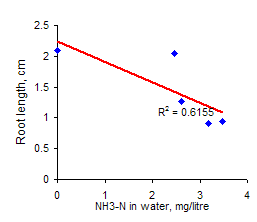 |
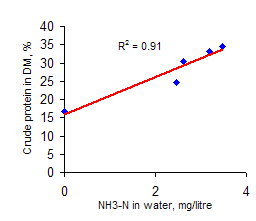 |
| Figure 7. Relationship between root length of duckweed and NH3-N of the pond water | Figure 7. Relationship between crude protein in the duckweed and NH3-N of the pond water |
Table 4. NH3-N and pH values in water fertilized by two sources of fertilizer |
||||
Levels of N (kg/ha)
|
NH3-N (mg/litre)
|
pH
|
||
|
Effluent |
Manure |
Effluent |
Manure |
|
|
0 |
0.00 |
0.00 |
7.2 |
7.2 |
|
50 |
2.46 |
1.74 |
6.9 |
6.8 |
|
100 |
2.62 |
1.17 |
7.3 |
6.9 |
|
150 |
3.19 |
4.22 |
7.3 |
6.9 |
|
200 |
3.47 |
4.18 |
7.4 |
7.0 |
Mean
|
2.35
|
2.26
|
7.2
|
6.9
|
Conclusions
- Fertilizing the pond water with effluent from biodigesters charged with cow manure supported higher yields of duckweed biomass, which was of higher crude protein content, as compared with the use of the raw cow manure.
- Increasing levels of N fertilizer in the pond increased biomass yield and crude protein content of the duckweed.
- The root length of the duckweed was inversely related to protein content, and this index is an excellent indicator of the protein status of this aquatic plant.
Acknowledgements
I am grateful to the MEKARN Program, supported by SIDA-SAREC, for
providing me the opportunity and financial support to learn and
conduct a mini project which helped me to understand more about conducting
experiments. Special thanks are given to Dr T R
Preston, Dr J Ly, Dr Do Van Xe and Dr Vo Tong Anh for
their support and for organizing the miniproject activities and providing
valuable suggestions and comments. Thanks are also given to the staff of UTA
(Cambodia), and of An Giang University, who provided practical support and
advice in assistance in the laboratory. Without this support I could not
have successfully carried out
the present investigation.
References
AOAC 1995 Official methods of Chemical Analysis. Association of
Official Analytical Chemists. 16th edition.
Arlington
Bui Hong Van, Le Thi Men, Vo Van Son and Preston T R
1997 Duckweed (Lemna spp) as protein supplement in an ensiled
cassava root diet for fattening pigs. Livestock Research for Rural
Development 9(1):
http://www.cipav.org.co/lrrd/lrrd9/1/lemen912
Cross J W 2001 Cham of duckweed: http.//www.usra.edu/~jwcross/duckweed.html (1 Apr
2001).
Du Tranh Hang 1998 Ensiled cassava leaves and duckweed as
protein sources for fattening pigs on farms in Central Vietnam.
Livestock Research for Rural Development (10) 3:
http://www.cipav.org.co/lrrd/lrrd10/3/hang2
Leng R A, Stamboli J H and Bell R 1995 Duckweed-A potential high protein feed resource for domestic animals and fish. Livestock Research for Rural Development 7(1): http://www.cipav.org.co/lrrd/lrrd7/1/3.htm
Le Ha Chau 1998 Biodigester effluent versus manure, from pigs or cattle, as fertilizer for duckweed (Lemna spp.). Livestock Research for Rural Development (10) 3: http://www.cipav.org.co/lrrd/lrrd10/3/chau2.htm
Ly J and Preston T R 1997 An approach to the estimation of washing loses in leaves of tropical trees. Livestock Research for Rural Development 9(3): http://www.cipav.org.co/lrrd/lrrd9/3/ly93.htm
Men Bui Xuan, Ogle B and Preston T R 1995
Use of duckweed (lemna
spp) as replacement for soya bean meal in a basal diet of broken rice for
fattening ducks. Livestock Research for Rural Development 7(3):
http://www.cipav.org.co/lrrd/lrrd3/2/2
Nguyen Duc Anh, Huu Tao and Preston T R 1997a Effect of management
practices and fertilization with biodigester effluent on biomass
yield and composition of duckweed. Livestock Research for Rural
Development
9(1):
http://www.cipav.org.co/lrrd/lrrd9/1/anh91
Nguyen Duc Anh and Preston T R 1997b Evaluation of protein quality
in duckweed (Lemna spp.) using a duckling growth assay. Livestock
Research for Rural Development
9(2):
http://www.cipav.org.co/lrrd/lrrd9/2/anh92
Nguyen Duc Anh and Preston T R 1998
Effect of exchange rates of
the media with biodigester effluent on biomass yield and
composition of duckweed. Livestock Research for Rural Development
10(1):
http://www.cipav.org.co/lrrd/lrrd10/1/anh101
Phengsavanh Phonepaseuth 2001
Respond of duckweed (Lemna minor)
growth to increasing concentrations of biodigester effluent and
rubber latex waste water in the pond. University of Tropical
Agriculture Foundation.
Rodriguez L and Preston T R 1996
Use of effluent from low cost plastic biodigester as fertilizer for duckweed
ponds. Livestock Research for Rural Development 8(2):
http://www.cipav.org.co/lrrd/lrrd8/2/lylian2
Undersander D, Martens D R and Thiex N 1993 Forage analysis procedures. National Forage Testing Association. Omaha

